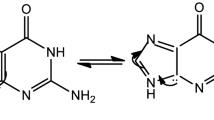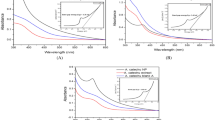Abstract
A new three-dimensional lanthanide metal–organic framework (Ln-MOF), [Eu4(L)4(H2O)8]·10H2O (1, H3L = biphenyl-3′-nitro-3,4′,5-tricarboxylic acid), has been constructed via solvothermal technology and its framework has been detected by the single-crystal X-ray diffraction and elemental analyses. Complex 1 with typical emission of Eu3+ ion represents dramatic luminescence quenching affect for picric acid (PA) and the linear Stern-Volmer plot was surveyed in the consistence, ranging from 0.05 to 0.15 mM (Ksv = 98,074 M− 1). Its therapeutic effect of the compound on the cerebral edema caused by cerebral hemorrhage was estimated and the mechanism was explored. Possible binding interactions have been investigated by molecular docking simulations, from which the binding interactions are identified and the carboxyl oxygens are responsible for those identified interactions.






Similar content being viewed by others
Data Availability
The data used to support the findings of this study are included within the article.
References
Veltkamp R, Purrucker J (2017) Management of spontaneous intracerebral hemorrhage. Curr Neurol Neurosci Rep 17:80
Gross BA, Jankowitz BT, Friedlander RM (2019) Cerebral intraparenchymal hemorrhage: a review. JAMA 321:1295–1303
Qureshi AI, Tuhrim S, Broderick JP, Batjer HH, Hondo H, Hanley DF (2001) Spontaneous intracerebral hemorrhage. N Engl J Med 344:1450–1460
Rachuri Y, Parmar B, Bisht KK, Suresh E (2017) Multiresponsive adenine-based luminescent Zn(II) coordination polymer for detection of Hg2+ and trinitrophenol in aqueous media. Cryst Growth Des 17:1363–1372
Jiang N, Liu Y, Yu XN, Zhang HB, Wang MM (2020) Corrosion resistance of nickel-phosphorus/nano-ZnO composite multilayer coating electrodeposited on carbon steel in acidic chloride environments. Int J Electrochem Sci 15:5520–5528
Geng J, Qin L, He C, Cui G (2012) Synthesis, crystal structures and catalytic properties of copper(II) and cobalt(II) coordination polymers based on a flexible benzimidazole ligand. Transit Met Chem 37:579–585
Zhao J, Zhang J, Zhang D, Hu Z, Sun Y (2021) Effect of emerging pollutant fluoxetine on the excess sludge anaerobic digestion. Sci Total Environ 752:141932
Gao L, Zhang J, Zhai L, Liang J, Liang J, Niu X, Hu T (2019) Fluorescent sensing properties of Cd(II)/Zn(II) metal–organic frameworks based on 3,5-di(2′,5′-dicarboxylphenyl)benozoic acid. Polyhedron 164:90–95
Duan C, Dong L, Li F, Xie Y, Huang B, Wang K, Yu Y, Xi H (2020) Room-temperature rapid synthesis of two-dimensional metal–organic framework nanosheets with tunable hierarchical porosity for enhanced adsorption desulfurization performance. Ind Eng Chem Res 59:18857–18864
Sun Y, Wu Y, Xiong G, Smet PF, Ding F, Guo M, Zhu M, Gao E, Poelman D, Verpoort F (2010) Hydrothermal synthesis, crystal structure and properties of Ag(i)–4f compounds based on 1H-benzimidazole-5,6-dicarboxylic acid. Dalt Trans 39:11383–11395
Li T, Kozlowski MT, Doud EA, Blakely MN, Rosi NL (2013) Stepwise ligand exchange for the preparation of a family of mesoporous MOFs. J Am Chem Soc 135:11688–11691
Zhou T, Du Y, Borgna A, Hong J, Wang Y, Han J, Zhang W, Xu R (2013) Post-synthesis modification of a metal-organic framework to construct a bifunctional photocatalyst for hydrogen production. Energy Environ Sci 6:3229–3234
Sen R, Saha D, Koner S (2012) Controlled construction of metal-organic frameworks: Hydrothermal synthesis, X-ray structure, and heterogeneous catalytic study. Chem - A Eur J 18:5979–5986
Jia XX, Yao RX, Zhang FQ, Zhang XM (2017) A FLUORESCENT ANIonic MOF with Zn4(trz)2 chain for highly selective visual sensing of contaminants: Cr(III) Ion and TNP. Inorg Chem 56:2690–2696
Goswami R, Seal N, Dash SR, Tyagi A, Neogi S (2019) Devising chemically robust and cationic Ni(II)–MOF with nitrogen-rich micropores for moisture-tolerant CO2 capture: highly regenerative and ultrafast colorimetric sensor for TNP and multiple oxo–anions in water with theoretical revelation. ACS Appl Mater Inter 11:40134–40150
Hu J, Wu K, Dong S, Zheng M (2018) A luminescent Cd(II)-MOF as recyclable bi-responsive sensor for detecting TNP and iron(III)/silver(I) with high selectivity and sensitivity. Polyhedron 153:261–267
Mukherjee S, Desai AV, Manna B, Inamdar AI, Ghosh SK (2015) Exploitation of guest accessible aliphatic amine functionality of a metal–organic framework for selective detection of 2,4,6-Trinitrophenol (TNP) in water. Cryst Growth Des 15:4627–4634
Wu K, Hu J, Shi S, Li J, Cheng X (2020) A thermal stable pincer-MOF with high selective and sensitive nitro explosive TNP, metal ion Fe3+ and pH sensing in aqueous solution. Dye Pigment 173:107993
Liu JM, Hou JX, Liu J, Jing X, Li LJ, Du JL (2019) Pyrazinyl-functionalized Zr(IV)-MOF for ultrasensitive detection of tyrosine/TNP and efficient CO2/N2 separation. J Mater Chem C 7:11851–11857
Kale SS, Bergeron-Brlek M, Wu Y, Kumar MG, Pham MV, Bortoli J, Vesin J, Kong XD, Machado JF, Deyle K, Gonschorek P, Turcatti G, Cendron L, Angelini A, Heinis C (2019) Thiol-to-amine cyclization reaction enables screening of large libraries of macrocyclic compounds and the generation of sub-kilodalton ligands. Sci Adv 5:eaaw2851
Lustig WP, Mukherjee S, Rudd ND, Desai AV, Li J, Ghosh SK (2017) Metal–organic frameworks: functional luminescent and photonic materials for sensing applications. Chem Soc Rev 46:3242–3285
Nagarkar SS, Joarder B, Chaudhari AK, Mukherjee S, Ghosh SK (2013) Highly selective detection of nitro explosives by a luminescent metal-organic framework. Angew Chemie 125:2953–2957
Rachuri Y, Parmar B, Suresh E (2018) Three-dimensional Co(II)/Cd(II) metal–organic frameworks: luminescent Cd-MOF for detection and adsorption of 2,4,6-trinitrophenol in the aqueous phase. Cryst Growth Des 18:3062–3072
Xing S, Bing Q, Qi H, Liu J, Bai T, Li G, Shi Z, Feng S, Xu R (2017) Rational design and functionalization of a zinc metal–organic framework for highly selective detection of 2,4,6-trinitrophenol. ACS Appl Mater Inter 9:23828–23835
Wei JZ, Wang XL, Sun XJ, Hou Y, Zhang X, Yang DD, Dong H, Zhang FM (2018) Rapid and large-scale synthesis of IRMOF-3 by electrochemistry method with enhanced fluorescence detection performance for TNP. Inorg Chem 57:3818–3824
Jin JC, Wu J, He YX, Li BH, Liu JQ, Prasad R, Kumar A, Batten SR (2017) A 3D luminescent Zn(ii) MOF for the detection of high explosives and the degradation of organic dyes: an experimental and computational study. CrystEngComm 19:6464–6472
Pal TK, Chatterjee N, Bharadwaj PK (2016) Linker-induced structural diversity and photophysical property of MOFs for selective and sensitive detection of nitroaromatics. Inorg Chem 55:1741–1747
Jin JC, Wu J, Liu WC, Ma AQ, Liu JQ, Singh A, Kumar A (2018) A new Zn(II) metal–organic framework having 3D CdSO4 topology as luminescent sensor and photocatalyst for degradation of organic dyes. New J Chem 42:2767–2775
Hong XJ, Wei Q, Cai YP, Zheng SR, Yu Y, Fan YZ, Xu XY, Si LP (2017) 2-fold interpenetrating bifunctional Cd-metal–organic frameworks: highly selective adsorption for CO2 and sensitive luminescent sensing of nitro aromatic 2,4,6-trinitrophenol. ACS Appl Mater Inter 9:4701–4708
Zhang X, Hu J, Li J, Liu T, Wang J, Ma X (2019) A bifunctional luminescent coordination polymer as recyclable sensor for detecting TNP and Fe3+ with high selectivity and sensitivity. Inorg Chim Acta 486:556–561
Karthik P, Pandikumar A, Preeyanghaa M, Kowsalya M, Neppolian B (2017) Amino-functionalized MIL-101(Fe) metal-organic framework as a viable fluorescent probe for nitroaromatic compounds. Microchim Acta 184:2265–2273
Morris GM, Huey R, Lindstrom W, Sanner MF, Belew RK, Goodsell DS, Olson AJ (2009) Autodock4 and autoDockTools4: automated docking with selective receptor flexiblity. J Comput Chem 16:2785–2791
Author information
Authors and Affiliations
Contributions
Xiao-Chang Chen carried out the experiments and analyzed the testing data.
Feng Xi performed the luminescent detection experiments and compared the results with the literature ones. Rong Liu accounts for the molecular docking.
Jia-Wen Zhou designed the whole experiments and wrote this manuscript.
Corresponding author
Ethics declarations
Conflict of Interest
The author(s) declare(s) that there is no conflict of interest regarding the publication of this paper.
Ethical Approval
All the procedures in the study were admitted by the Animal Ethics Committee of the Nanjing University (Nanjing, China).
Additional information
Publisher’s Note
Springer Nature remains neutral with regard to jurisdictional claims in published maps and institutional affiliations.
Rights and permissions
About this article
Cite this article
Chen, XC., Xi, F., Liu, R. et al. A Eu(III)-based Metal Organic Framework: Selective Sensing of Picric Acid and Nursing Application Values On the Cerebral Edema Induced by Cerebral Hemorrhage Via Reducing the Coagulation Factor II Activity. J Fluoresc 31, 385–392 (2021). https://doi.org/10.1007/s10895-020-02667-z
Received:
Accepted:
Published:
Issue Date:
DOI: https://doi.org/10.1007/s10895-020-02667-z




